The crow family, scientifically known as Corvidae, is a fascinating and diverse group of birds that captivates birdwatchers and nature enthusiasts alike. From the commonly seen magpie flashing its iridescent tail to the elusive jay hidden within woodland canopies, these birds, collectively called corvids, share remarkable intelligence and adaptability. They thrive in various habitats, utilize diverse food sources, and exhibit resourceful nesting strategies. But with such a variety of species, how can you distinguish between them? Let’s delve into the world of Crow Family Birds, exploring their defining characteristics and providing you with the knowledge to confidently identify these intelligent creatures.
 A flock of crow family birds, also known as corvids, in flight, showcasing their impressive aerial abilities and social behavior.
A flock of crow family birds, also known as corvids, in flight, showcasing their impressive aerial abilities and social behavior.
Corvidae is a globally distributed family of passerine birds belonging to the oscine suborder, encompassing an impressive 133 species. Renowned for their intelligence, corvids have consistently demonstrated exceptional problem-solving skills in numerous scientific studies. Their cognitive abilities extend beyond puzzles; they are also adept communicators, interacting both within their species and even with other animals. Furthermore, corvids possess a remarkable talent for mimicry, capable of imitating a wide range of sounds, including human speech. Intriguingly, research indicates that despite their relatively small brain size, corvids possess a higher neuron density compared to primates with larger brains. This suggests that the extraordinary intelligence and complex behaviors observed in crow family birds are a product of convergent evolution, highlighting nature’s ingenious solutions to cognitive development^1.
Exploring the Diversity: Birds Within the Crow Family
As mentioned, the crow family boasts a rich tapestry of 133 species worldwide. This includes a variety of unique birds such as colorful treepies, seed-caching nutcrackers, striking oriental magpies, and the African savanna dwelling piapiacs. Within the United Kingdom, while the global family is large, only 8 species are known to breed, making them key representatives of the crow family in this region^2. Let’s focus on these UK breeding members of the crow family, providing detailed identification tips to help you tell them apart.
Carrion Crow
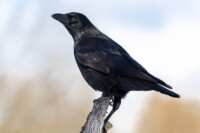 A detailed close-up of a Carrion Crow, showcasing its all-black plumage and intelligent gaze, a common sight in the UK.
A detailed close-up of a Carrion Crow, showcasing its all-black plumage and intelligent gaze, a common sight in the UK.
Scientific Name: Corvus corone
Conservation Status: Green (Least Concern)
Population: Approximately 1,000,000 territories in the UK
The carrion crow is arguably the most familiar member of the crow family across the UK. Recognized as one of Britain’s most intelligent birds, they are remarkably adaptable and can thrive in diverse environments. However, their wariness towards humans is a lasting consequence of historical persecution. While carrion crows may occasionally gather in flocks, they are typically solitary birds, often observed alone or in pairs.
How to Identify a Carrion Crow: Key Features
The carrion crow presents an entirely black appearance, encompassing its feathers, beak, and legs. In bright sunlight, however, you might notice a subtle iridescent sheen of purple or blue on their wing and nape feathers. During flight, the carrion crow exhibits rounded wingtips and a substantial wingspan reaching up to 104 cm. They are commonly found in parks, woodlands, and farmland areas. Listen for their characteristic solitary ‘caw’ cry, a key identifier.
Chough
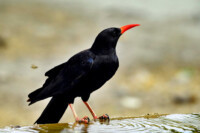 A vibrant Chough perched on a coastal cliff, highlighting its distinctive red beak and legs against its black plumage.
A vibrant Chough perched on a coastal cliff, highlighting its distinctive red beak and legs against its black plumage.
Scientific Name: Pyrrhocorax pyrrhocorax
Conservation Status: Green (Least Concern)
Population: Estimated 250 – 350 pairs in the UK
The chough, pronounced “chuff,” stands out within the crow family due to its striking red and black coloration. These birds are renowned for their agile flight, capable of impressive dives and swoops when pursuing prey or evading predators. While choughs can be seen in flocks during autumn and winter, they are primarily associated with the western regions of Britain, particularly coastal areas.
How to Identify a Chough: Distinctive Markers
Choughs are easily distinguished from other crow family members by their vibrant red bill and legs. Their plumage is a deep, glossy black, firmly placing them within the corvid family. Often referred to as the “coastal crow,” choughs favor nesting on cliffs, utilizing their specialized, downturned beaks to forage for food in nearby grasslands. Although they may resemble jackdaws in flight, their unique ‘chee-ow’ call provides a clear auditory identification cue.
Hooded Crow
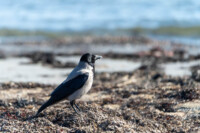 A Hooded Crow in its typical stance, showing its contrasting grey body and black head, wings, and tail.
A Hooded Crow in its typical stance, showing its contrasting grey body and black head, wings, and tail.
Scientific Name: Corvus cornix
Conservation Status: Green (Least Concern)
Population: Approximately 260,000 pairs in the UK
The hooded crow’s close relationship and resemblance to the carrion crow led to its relatively recent classification as a distinct species. Hooded crows are notably more sociable than carrion crows, frequently observed in groups. In areas where their territories overlap, interbreeding can occur, resulting in hybrid birds exhibiting a mix of hooded and carrion crow characteristics.
How to Identify a Hooded Crow: Key Differences
Despite their similarities to carrion crows, hooded crows possess a distinct appearance. The hooded crow displays a contrasting color pattern: a black head, wings, and tail combined with a grey body, unlike the entirely black plumage of the carrion crow. Their social nature, often feeding in groups, can also aid in identification. Hooded crows are most prevalent in Ireland and Scotland, where they have largely replaced the carrion crow in many habitats.
Jackdaw
 A curious Jackdaw perched on a branch, showcasing its smaller size and pale eyes, a common garden visitor.
A curious Jackdaw perched on a branch, showcasing its smaller size and pale eyes, a common garden visitor.
Scientific Name: Corvus monedula
Conservation Status: Green (Least Concern)
Population: Approximately 1,400,000 pairs in the UK
The jackdaw is a surprisingly vocal bird frequently encountered in gardens and parks, particularly those bordering urban areas. Highly agile, jackdaws are known to cling to mesh bird feeders with ease. During winter, large gatherings of jackdaws often form dusk roosts, creating spectacular aerial displays as they “dance” through the sky before settling into tall trees for the night.
How to Identify a Jackdaw: Size and Markings
Jackdaws are among the smaller members of the crow family, characterized by black feathers with a distinctive silver sheen around the nape of their neck. A key identifying feature is their pale eyes, which are a striking blue-grey color. They typically nest in loose colonies, favoring locations with abundant holes and crevices. Listen for their loud, characteristic ‘tchack’ call, from which their name is derived.
Jay
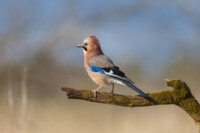 A colorful Jay in its woodland habitat, displaying its pinkish-brown plumage and striking blue wing patch.
A colorful Jay in its woodland habitat, displaying its pinkish-brown plumage and striking blue wing patch.
Scientific Name: Garrulus glandarius
Conservation Status: Green (Least Concern)
Population: Approximately 170,000 territories in the UK
Despite being the most vibrantly colored member of the crow family in the UK, the jay is surprisingly elusive. These shy birds prefer dense cover and are often heard rather than seen. Jays are considered highly intelligent, particularly renowned for their exceptional memory. Their primary diet consists of acorns and nuts, which they diligently bury in autumn, remembering the locations of hundreds of caches to retrieve food throughout the winter, ensuring their survival.
How to Identify a Jay: Coloration and Behavior
Jays are cautious woodland inhabitants, their coloration providing excellent camouflage within their environment. They exhibit pinkish-brown plumage with distinctive black and white wing feathers and prominent blue streaks. Their wings are shorter and more rounded than other corvids, aiding maneuverability through trees. To spot a jay, listen for its loud, screaming call, often signaling an impending movement, then watch for the flash of white on its rump as it takes flight.
Magpie
 A bold Magpie perched prominently, showcasing its black and white plumage and long, iridescent tail.
A bold Magpie perched prominently, showcasing its black and white plumage and long, iridescent tail.
Scientific Name: Pica pica
Conservation Status: Green (Least Concern)
Population: Approximately 600,000 territories in the UK
The magpie is a commonly sighted and unmistakable member of the crow family, known for its lack of shyness. Magpies are opportunistic scavengers and effective pest controllers, while also being skilled predators. Despite being sometimes unfairly blamed for songbird declines due to egg and fledgling predation, scientific evidence does not support this claim, so their presence in gardens should not be a cause for concern.
How to Identify a Magpie: Unmistakable Appearance
Magpies are instantly recognizable corvids with their striking black and white plumage and exceptionally long tail, which exhibits a green iridescence. In sunlight, their black feathers can display blue or purple hues. Magpies are bolder and more conspicuous than other crow family members, frequently seen in gardens and parks across the UK.
Raven
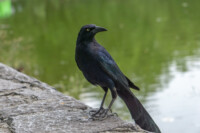 A majestic Raven in flight, highlighting its large size, diamond-shaped tail, and powerful wingspan.
A majestic Raven in flight, highlighting its large size, diamond-shaped tail, and powerful wingspan.
Scientific Name: Corvus corax
Conservation Status: Green (Least Concern)
Population: Approximately 7,400 pairs in the UK
The raven is the largest member of the crow family, with some individuals reaching impressive sizes of up to 68 cm in length. Known for their strength, ravens have been observed preying on animals as large as rabbits and pheasants. Similar to carrion crows, ravens have historically faced persecution due to their predatory behavior. However, they are generally more social than carrion crows and can be found in groups of up to half a dozen.
How to Identify a Raven: Size and Flight Silhouette
Ravens are large, imposing black birds with a metallic grey sheen visible in sunlight and a heavy black bill. In flight, a raven is distinguished by its diamond-shaped tail and an expansive wingspan reaching up to 150 cm. Ravens are expanding their breeding range and can be found in upland habitats like hills and moors, as well as tall trees in lowland areas. Their deep, croaking call is a distinctive auditory identifier.
Rook
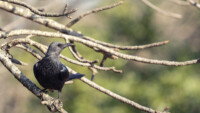 A group of Rooks foraging in a field, showing their shaggy plumage and pale beak base, often seen in farmland.
A group of Rooks foraging in a field, showing their shaggy plumage and pale beak base, often seen in farmland.
Scientific Name: Corvus frugilegus
Conservation Status: Amber (Medium Conservation Concern)
Population: Approximately 1,100,000 pairs in the UK
Rooks are commonly associated with farmland and are highly sociable birds. Their large nesting colonies, known as rookeries, are a prominent feature in the landscape during the first half of the year. In winter, rooks often congregate in massive flocks, sometimes numbering thousands. Unfortunately, the rook is the only UK crow family member with an Amber conservation status, indicating a moderate concern due to a recent decline in breeding pairs.
How to Identify a Rook: Facial Features and Plumage
Rooks are readily identified within the crow family by their distinctive thin, whitish beak and the bare, greyish-white skin around the base of the beak in adults. They have a somewhat shaggy appearance compared to other corvids, with their black plumage often looking slightly ruffled. Rooks are frequently seen in association with jackdaws, but are distinguishable by their peaked head shape and pale facial features.
Attracting Crow Family Birds to Your Garden
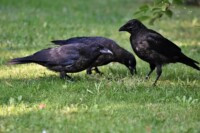 A pair of Carrion Crows in a garden setting, demonstrating their adaptability to human environments.
A pair of Carrion Crows in a garden setting, demonstrating their adaptability to human environments.
Despite their cautious nature and sometimes solitary habits, many members of the crow family will visit gardens in search of food. Once they recognize a garden as a safe and reliable food source, they will become regular visitors, particularly carrion crows. Contrary to some negative perceptions, crows can be beneficial garden inhabitants, contributing to waste cleanup and effective pest control. Remarkably, a single crow can consume up to 40,000 insects during a nesting season^3!
To encourage crow family birds and other corvids to visit your garden, consider these simple steps:
- Offer Suitable Food: Corvids can be selective eaters, but unsalted bird peanuts are generally a popular choice.
- Use Appropriate Feeders: Crows naturally feed on the ground, so elevated feeders are unlikely to attract them. Opt for a ground feeder placed in an open area visible from above.
- Provide a Water Source: Like all birds, corvids need water for drinking and bathing. Install a bird bath in your garden to provide a valuable water source, especially during warmer months.
- Minimize Noise: While corvids themselves are often vocal, excessive external noise can startle them. Reduce potential disturbances in your garden, such as wind chimes or creaking gates, to create a more welcoming environment.
- Observe from a Distance: Many corvids, especially crows, are naturally wary of humans due to past persecution. To encourage them to return, observe them from a distance to avoid causing alarm.
Appreciating the Crow Family
Hopefully, you are now better equipped to distinguish a carrion crow from a jackdaw and identify other fascinating members of the crow family! Whether you aim to support crows in your garden or simply enjoy spotting them in the wild, the crow family offers endless interest and exemplifies the intelligence and adaptability of the avian world.
Share your own experiences with crow family birds and observations!
